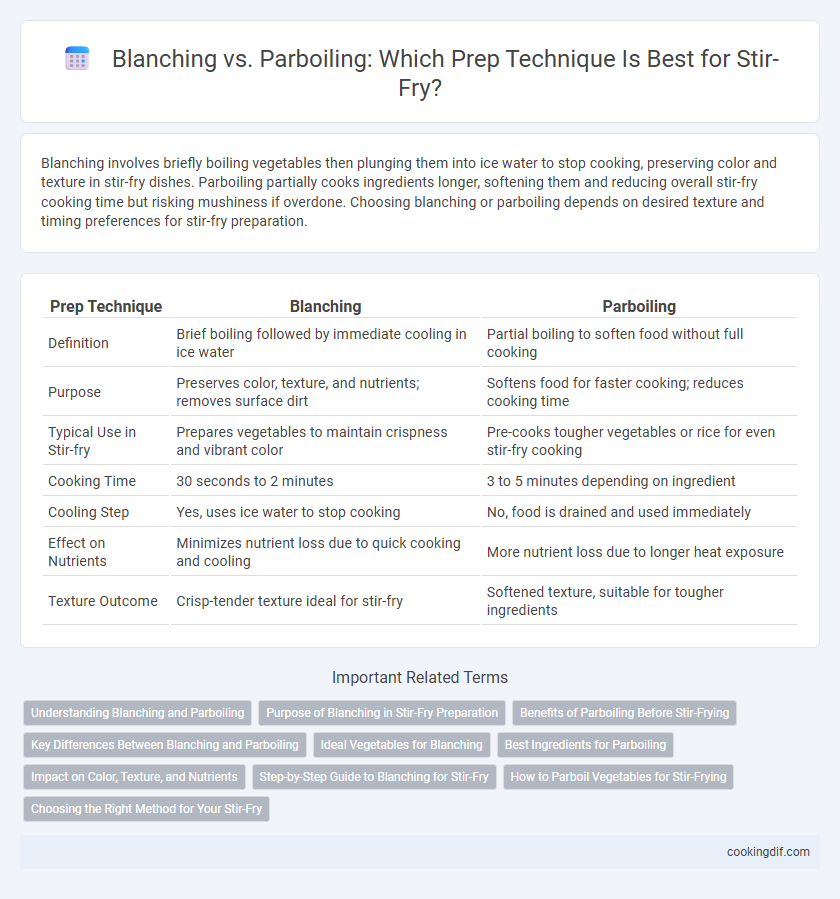Blanching involves briefly boiling vegetables then plunging them into ice water to stop cooking, preserving color and texture in stir-fry dishes. Parboiling partially cooks ingredients longer, softening them and reducing overall stir-fry cooking time but risking mushiness if overdone. Choosing blanching or parboiling depends on desired texture and timing preferences for stir-fry preparation.
Table of Comparison
| Prep Technique | Blanching | Parboiling |
|---|---|---|
| Definition | Brief boiling followed by immediate cooling in ice water | Partial boiling to soften food without full cooking |
| Purpose | Preserves color, texture, and nutrients; removes surface dirt | Softens food for faster cooking; reduces cooking time |
| Typical Use in Stir-fry | Prepares vegetables to maintain crispness and vibrant color | Pre-cooks tougher vegetables or rice for even stir-fry cooking |
| Cooking Time | 30 seconds to 2 minutes | 3 to 5 minutes depending on ingredient |
| Cooling Step | Yes, uses ice water to stop cooking | No, food is drained and used immediately |
| Effect on Nutrients | Minimizes nutrient loss due to quick cooking and cooling | More nutrient loss due to longer heat exposure |
| Texture Outcome | Crisp-tender texture ideal for stir-fry | Softened texture, suitable for tougher ingredients |
Understanding Blanching and Parboiling
Blanching involves briefly boiling vegetables followed by immediate cooling in ice water to halt cooking, preserving color, texture, and nutrients. Parboiling partially cooks ingredients by boiling them until slightly tender without fully softening, facilitating even stir-frying and reducing final cooking time. Both techniques optimize stir-fry prep by ensuring ingredients cook uniformly while retaining crispness and vibrant appearance.
Purpose of Blanching in Stir-Fry Preparation
Blanching in stir-fry preparation serves to partially cook vegetables while preserving their vibrant color, crisp texture, and nutritional value. This technique involves briefly boiling vegetables and immediately shocking them in ice water to halt the cooking process, enhancing their overall appearance and flavor retention. Compared to parboiling, blanching is optimized to prevent overcooking and maintain the ideal texture for quick stir-fry cooking.
Benefits of Parboiling Before Stir-Frying
Parboiling vegetables before stir-frying partially cooks them, reducing overall stir-fry time and ensuring even texture and tenderness. This preparation method helps retain vibrant color and nutrients while achieving a crisp-tender bite. Parboiling also minimizes moisture release during stir-frying, preventing sogginess and enhancing flavor concentration.
Key Differences Between Blanching and Parboiling
Blanching involves briefly boiling vegetables followed by immediate cooling in ice water to halt cooking, preserving color, texture, and nutrients, essential for stir-fry prep. Parboiling partially cooks vegetables or grains in boiling water without cooling, softening them for faster final cooking but risking nutrient loss and over-softening. Understanding these key differences ensures optimal texture and flavor in stir-fry dishes by selecting the right technique based on ingredient and desired doneness.
Ideal Vegetables for Blanching
Blanching is ideal for crisp vegetables like green beans, broccoli, and snow peas, as it quickly softens while retaining vibrant color and nutrients. This technique brightens leafy greens and tender roots without the risk of overcooking, making them perfect for stir-fry dishes. Parboiling, by contrast, is better suited for denser vegetables that require longer cooking times, such as carrots and potatoes.
Best Ingredients for Parboiling
Parboiling is ideal for denser vegetables like carrots, potatoes, and cauliflower, which benefit from partial cooking to soften their texture before stir-frying. Leafy greens and tender vegetables such as spinach or bell peppers are less suitable for parboiling since they cook quickly and can become mushy. Using parboiling for these hardy ingredients ensures even cooking and a crisp-tender finish in the final stir-fry dish.
Impact on Color, Texture, and Nutrients
Blanching preserves vibrant color and firm texture by briefly cooking vegetables in boiling water followed by immediate cooling, which locks in nutrients and prevents overcooking. Parboiling softens vegetables through partial cooking but can cause color fading, nutrient loss, and a mushier texture due to longer boiling times. Choosing blanching over parboiling enhances stir-fry vegetables' crispness, bright appearance, and nutritional value.
Step-by-Step Guide to Blanching for Stir-Fry
Blanching for stir-fry involves briefly boiling vegetables for 1-3 minutes until crisp-tender, then immediately plunging them into ice water to halt cooking and preserve vibrant color. This technique enhances texture by softening tough fibers without overcooking, ensuring vegetables retain crunch during stir-frying. Proper blanching prevents uneven cooking and allows faster stir-fry execution, making it essential for ingredients like broccoli, green beans, or snow peas.
How to Parboil Vegetables for Stir-Frying
Parboiling vegetables for stir-frying involves partially cooking them in boiling water for a brief time, usually 1 to 3 minutes, to soften without fully cooking, which preserves texture and color. Use ample boiling water, submerge the vegetables evenly, and immediately transfer them to an ice bath to halt cooking and maintain crispness. This technique ensures vegetables are tender yet firm, facilitating quick stir-fry cooking and enhancing flavor absorption.
Choosing the Right Method for Your Stir-Fry
Blanching preserves the vibrant color and crisp texture of vegetables, making it ideal for quick stir-fry dishes that require uniform cooking. Parboiling softens denser ingredients like root vegetables or tougher greens, ensuring they cook evenly without overcooking delicate stir-fry components. Selecting blanching or parboiling depends on the vegetable's texture and desired outcome, optimizing flavor and cooking efficiency in stir-fry recipes.
Blanching vs Parboiling for prep technique Infographic

 cookingdif.com
cookingdif.com